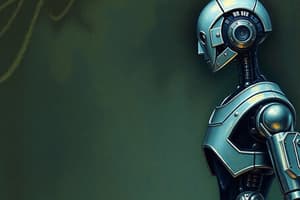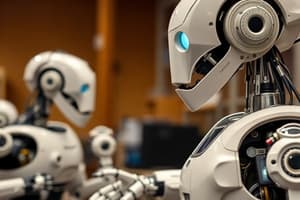Podcast
Questions and Answers
Who created the first recorded attempt at creating a robotic device in 250 BCE?
Who created the first recorded attempt at creating a robotic device in 250 BCE?
Archytas of Tarentum
What famous Greek automaton maker devised a series of self-operating machines that included a primitive robot?
What famous Greek automaton maker devised a series of self-operating machines that included a primitive robot?
Hero of Alexandria
In which centuries did the Industrial Revolution bring about a surge in mechanization and automation?
In which centuries did the Industrial Revolution bring about a surge in mechanization and automation?
18th and 19th centuries
Who developed the programmable automaton called 'The Dancing Doll' in 1737?
Who developed the programmable automaton called 'The Dancing Doll' in 1737?
Which English mathematician and inventor laid the groundwork for computers and also conceived of a self-replicating robot in the early 19th century?
Which English mathematician and inventor laid the groundwork for computers and also conceived of a self-replicating robot in the early 19th century?
What field merges technology and engineering to create machines that mimic biological systems?
What field merges technology and engineering to create machines that mimic biological systems?
Who are some notable creators of mechanical automata from the late 18th and early 19th centuries?
Who are some notable creators of mechanical automata from the late 18th and early 19th centuries?
What is the Jacquard Loom and who developed it?
What is the Jacquard Loom and who developed it?
Who were some key figures in early robotics research during the mid-20th century?
Who were some key figures in early robotics research during the mid-20th century?
What was the first programmable industrial robot and who developed it?
What was the first programmable industrial robot and who developed it?
How did the space race in the 1960s contribute to advancements in robotics?
How did the space race in the 1960s contribute to advancements in robotics?
What are some technological advancements in the 21st century that have contributed to the growth of robotics?
What are some technological advancements in the 21st century that have contributed to the growth of robotics?
Flashcards are hidden until you start studying
Study Notes
Unraveling Robotics: A Journey through Time
Robotics, a field that merges technology and engineering to create machines that mimic biological systems, has a rich and fascinating history spanning centuries. From the first crude prototypes to the sophisticated machines we see today, robotics has come a long way. This article will delve into the evolution of robotics, highlighting key milestones and pioneers that have shaped our understanding and capabilities in this field.
Early Beginnings
The concept of automated machines can be traced back to ancient civilizations. In 250 BCE, the mathematician and inventor Archytas of Tarentum created a wooden pigeon powered by steam, marking the first recorded attempt at creating a robotic device. A millennium later, the Greek automaton maker Hero of Alexandria devised a series of self-operating machines that included a primitive robot.
Industrial Revolution
In the 18th and 19th centuries, the Industrial Revolution brought about a surge in mechanization and automation. In 1737, Jacob Fabri developed a programmable automaton called "The Dancing Doll," considered the first example of a programmable machine. The famous English mathematician and inventor Charles Babbage, who laid the groundwork for computers with his designs for the Analytical Engine, also conceived of a self-replicating robot in the early 19th century.
Automata and Mechanical Wonders
During the late 18th and early 19th centuries, mechanical automata, or self-operating machines, became popular attractions at fairs and exhibitions. These intricate devices often mimicked human or animal behaviors, such as writing, playing music, or moving their arms and legs. Some of the most notable creators of these automata include Pierre Jaquet-Droz, Henri Maillardet, and Joseph-Marie Jacquard, who developed the Jacquard Loom, a precursor to modern computer programming.
Influence of the Computer Age
The advent of computers in the mid-20th century had a profound impact on robotics. Early robotics research, spearheaded by figures like George C. Devol, Joseph Engelberger, and William Grey Walter, focused on utilizing programmable devices to perform tasks efficiently and reliably. The first programmable industrial robot, Unimate, was developed by Devol and Engelberger and used in General Motors' factories in 1961.
Robotic Advancements in Space
The space race between the United States and the Soviet Union in the 1960s fueled innovation in robotics. Robotic devices were deployed to perform dangerous and physically demanding tasks, such as exploring the moon's surface and repairing spacecraft in orbit. The Ranger, Lunar Orbiter, and Viking missions are among the most notable space exploration programs that utilized robotic technologies.
Modern Robotics
In the 21st century, robotics has experienced a period of rapid growth and innovation. Advances in artificial intelligence, computer vision, and sensor technology have enabled the development of increasingly sophisticated machines capable of performing a wide range of tasks. From autonomous vehicles to surgical robots and drones, the applications of robotics continue to expand across various industries.
Conclusion
As robotics evolves, so too do our expectations and aspirations for the field. From its humble beginnings in ancient Greece to the cutting-edge technology of today, robotics has offered a unique perspective on how humans interact with machines and the world around us. As we continue to explore the potential of robotics, it is essential to remember our rich history and the pioneers who paved the way for this exciting field.
Studying That Suits You
Use AI to generate personalized quizzes and flashcards to suit your learning preferences.




